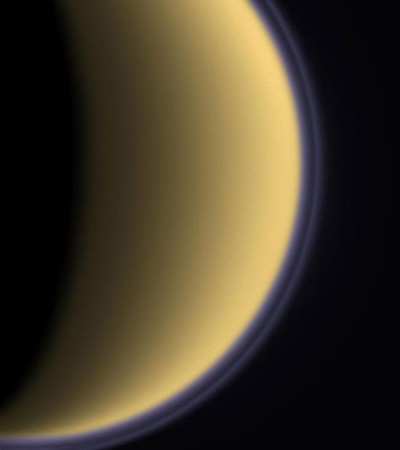Posted -- No Swimming
Scientists are fascinated by a dark, lake-like feature recently
observed on Saturn's moon Titan. NASA's Cassini spacecraft captured
a series of images showing a marking, darker than anything else
around it. It is remarkably lake-like, with smooth, shore-like
boundaries unlike any seen previously on Titan.

"I'd say this is definitely the best candidate we've seen so far
for a liquid hydrocarbon lake on Titan," said Dr. Alfred McEwen,
Cassini imaging team member and a professor at the University of
Arizona, Tucson. The suspected lake area measures 234 kilometers
long by 73 kilometers wide (145 miles by 45 miles), about the size
of Lake Ontario, on the U.S. Canadian border.
"This feature is unique in our exploration of Titan so far,"
said Dr. Elizabeth Turtle, Cassini imaging team associate at the
University of Arizona. "Its perimeter is intriguingly reminiscent
of the shorelines of lakes on Earth that are smoothed by water
erosion and deposition."
The feature lies in Titan's cloudiest region, which is
presumably the most likely site of recent methane rainfall. This,
coupled with the shore-like smoothness of the feature's perimeter
makes it hard for scientists to resist speculation about what might
be filling the lake, if it indeed is one.
"It's possible that some of the storms in this region are strong
enough to make methane rain that reaches the surface," said Cassini
imaging team member Dr. Tony DelGenio of NASA's Goddard Institute
for Space Studies in New York.

"Given Titan's cold temperatures, it could take a long time for
any liquid methane collecting on the surface to evaporate. So it
might not be surprising for a methane-filled lake to persist for a
long time," DelGenio added.
Despite earlier predictions, no definitive evidence for open
bodies of liquid has been found on Titan. Cassini has not yet been
in a favorable position for using its cameras to check for glints
from possible surface liquids in the south polar region.
"Eventually, as the seasons change over a few years, the
convective clouds may migrate northward to lower latitudes," said
DelGenio, "If so, it will be interesting to see whether the Cassini
cameras record changes in the appearance of the surface as
well."
"An alternate explanation is that this feature was once a lake,
but has since dried up, leaving behind dark deposits," Turtle said.
Yet another possibility is that the lake is simply a broad
depression filled by dark, solid hydrocarbons falling from the
atmosphere onto Titan's surface. In this case, the smooth outline
might be the result of a process unrelated to rainfall, such as a
sinkhole or a volcanic caldera.

"It reminds me of the lava lakes seen on Jupiter's moon, Io,"
Dr. Torrence Johnson, an imaging team member at NASA's Jet
Propulsion Laboratory in Pasadena, CA.
"It is already clear that whatever this lake-like feature turns
out to be, it is only one of many puzzles that Titan will throw at
us as we continue our reconnaissance of the surface over the next
few years," said Dr. Carolyn Porco, imaging team leader at the
Space Science Institute in Boulder, CO.
Thirty-nine more Titan flybys are planned for Cassini's prime
mission. In future flybys the science teams will search for
opportunities to observe the lake feature again and to look for
mirror-like reflections from smooth surfaces elsewhere on Titan.
Such reflections would strongly support the presence of
liquids.
The Cassini-Huygens mission is a cooperative project of NASA,
the European Space Agency and the Italian Space Agency. JPL manages
the Cassini mission for NASA's Science Mission Directorate,
Washington. The Cassini orbiter and its two onboard cameras were
designed, developed and assembled at JPL. The imaging team is based
at the Space Science Institute in Boulder.
 Airbus Racer Helicopter Demonstrator First Flight Part of Clean Sky 2 Initiative
Airbus Racer Helicopter Demonstrator First Flight Part of Clean Sky 2 Initiative Diamond's Electric DA40 Finds Fans at Dübendorf
Diamond's Electric DA40 Finds Fans at Dübendorf ANN's Daily Aero-Term (04.23.24): Line Up And Wait (LUAW)
ANN's Daily Aero-Term (04.23.24): Line Up And Wait (LUAW) NTSB Final Report: Extra Flugzeugbau GMBH EA300/L
NTSB Final Report: Extra Flugzeugbau GMBH EA300/L Classic Aero-TV: 'Never Give Up' - Advice From Two of FedEx's Female Captains
Classic Aero-TV: 'Never Give Up' - Advice From Two of FedEx's Female Captains





